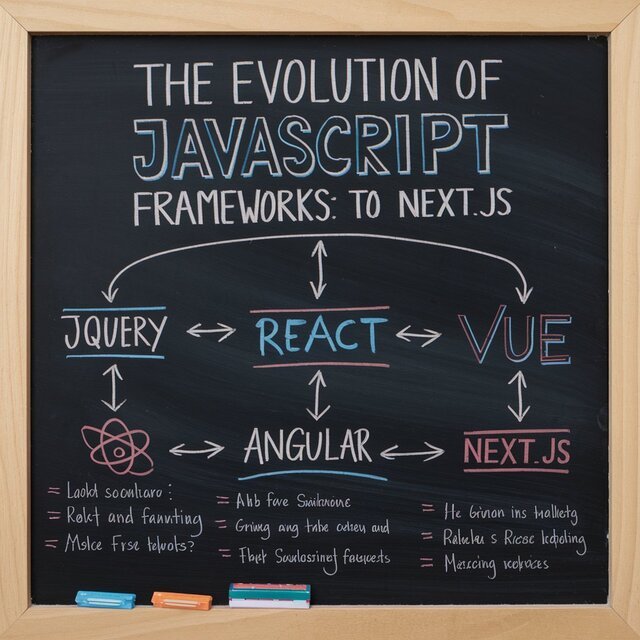
Over a decade and a half, the evolution of the JavaScript ecosystem has gone from a minimalist DOM manipulation library to a very large framework managing complex web applications. The change reflected the changing demands of web development, as well as how developers have been very ingenious in tackling emerging challenges. This comprehensive analysis traces the journey of JavaScript frameworks from jQuery to Next.js, examines key milestones, paradigm shifts, and the technological innovations that fashion modern web development.
In the early 1990’s, JavaScript was developed by Brendan Eich at Netscape Communications Corporation. Initially, it was called “Mocha,” then renamed “Live Script,” and finally became “JavaScript,” when the two firms, Netscape and Sun, announced it would be an open cross-platform object scripting language for enterprise networks and the Internet. 1999-2007 was also the time that witnessed browser wars against Internet Explorer fighting for its life against the Mozilla Firefox, thus creating many problems for developers who tried to make cross-browser adoptive applications.
The landscape began changing really in 2008, actually, with the launch of Chrome by Google-it was then the fastest web browser. It was also at this period that ECMAScript 4 was abandoned and Node.js created, expanding JavaScript out of the browser. These laid the groundwork for the birth of more advanced JavaScript frameworks.
Prior to the rise of modern frameworks, jQuery had defined the JavaScript landscape by providing a beautiful solution to the greatest concern of that time: inconsistent browser implementations. jQuery simplified DOM manipulation, event handling, animation, and AJAX calls using a clean, intuitive API that consistently worked across different browsers.
The architecture of jQuery’s plugins allowed developers to add to its capabilities, provoking tools like the timeline visualization plugin for the creative presentation of historical data. It fundamentally changed the way developers work with JavaScript and made web interactivity accessible to a much larger chunk of developers while establishing patterns to shape future frameworks.

With the rise of web applications to greater complexity, the need for a better architectural pattern arose to manage the growing complexity. These needs spawned Model-View-Controller (MVC)-based frameworks, with real changes brought in by AngularJS.
The release of AngularJS in 2010 marked a series of paradigm shifts such as two-way data binding and dependency injection to frontend development. AngularJS brought some structure to web application architecture with the implementation of the MVC paradigm and introduced directives that extended HTML syntax. It was a paradigm shift away from procedural jQuery to a more structured methodology apt for building complex applications.
The Component-Based Architecture Revolution
The next big landmark came with the open-sourcing of React by Facebook in the year 2013, introducing a completely new paradigm for UI development. The component-based architecture of React and the Virtual DOM concept drastically altered how developers-built user interfaces. React allows thinking of interfaces as compositions of small, reusable components with unidirectional data flow, thereby providing a more predictable and maintainable means to construct complex UIs.
The impact of React has been far-reaching, inspiring a number of frameworks that followed it, and turning into a new paradigm for frontend development. Its emphasis on compositions of reusable components afforded better separation of concerns and organization of code for ever-increasing complexities facing web applications.
In 2014, Evan You launched Vue.js and described it as a “Progressive Framework” that would enable incremental adoption. Vue.js aimed to be hybrid, maintaining Angular’s template syntax, wrapping that with a component-based architecture of React, with an emphasis on simplicity and ease integration.
Vue’s rapid success is attributed to its gentle learning curve and flexible architecture. Its progressive nature allowed developers to adopt it gradually in already-existing projects, making it especially attractive for teams involved in incremental modernization. This countered the notion that when a framework is powerful, it must also be hard to learn, proving instead that a case can be made for frameworks to be both advanced and accessible.
The evolutionary path encountered another tangent in 2016 when Rich Harris launched Svelte, introducing a compiler-based paradigm enabling shifting of processing from runtime to build time. In contrast to React and Vue, which employ a virtual DOM at runtime, Svelte compiles components to highly efficient vanilla JavaScript which directly manipulates the DOM when state changes.
This innovative design challenged the existing dominance of virtual DOM as a paradigm, laying down viable alternatives for creating reactive interfaces, which might actually perform better. Svelte’ s arrival emphasized that the evolution of frameworks is not always linear, and revolutionary designs can emerge to challenge even the very basic assumptions of earlier technologies.
Similarly, in 2016, Vercel (formerly Zeit) saw the emergence of Next.js, a React framework created by Guillermo Rauch. Next.js responded to very real concerns of modern web development, specifically concerning server-side rendering and static site generation.
Rauch had an enlightened view: he felt that rendering should take place as close to the database as possible, to recover the data and present it with maximum efficiency. This philosophy placed server-side rendering in the driver’s seat to enable swift content generation on the server for immediate delivery to clients. Thus, Next.js glides gracefully, enabling faster page loads and better SEO via pre-rendering, while at the same time making development easy and improving application performance.

The JavaScript framework ecosystem is experiencing fast-paced evolution. React introduced Hooks in 2019 to allow use of state and lifecycle features in functional components to ease the component model. This created less need for class components and provides a more uniform way of dealing with component logic.
Next.js will become a hallmark by 2025 for the new age web development. The App Router brought with Next.js 13 is server-first with React Server Components, simpler routing with nested layouts, better loading and error states, and good streaming capabilities. There are constant enhancements in these areas with performance, developer experience, and tackling real-world problems for web application development as a focus.
Current research shows Type Safety is the guiding light for best practices in JavaScript Framework development. TypeScript has gained momentum, making it a standard for professional applications. In the eyes of Next.js users in 2025, use of TypeScript is mandatory rather than optional, with advantages such as the ability to catch errors before entering production, enhanced IDE support, improved maintainability, and easier onboarding of new team members.
Security issues are getting prominent too, with insight studies showing that third-party dependencies used in frameworks such as React need an effective way to manage vulnerabilities. This is testimony of the maturing ecosystem to address not just functional requirements but also highly mission-critical non-functional issues such as security and maintainability.
The evolution of JavaScript frameworks has occurred in response to certain technical challenges. One such challenge was crawling AJAX-based web applications, whose multiple states were tied to a single URL on one hand but made it difficult for search engines to resolve that particular URL on the other. Modern frameworks do server-side rendering and state management related to application-state solutions, and so offer improvements over the aforementioned limitation, as in Next.js.
Performance optimization is the other technical challenge. Another generation of frameworks brought in yet another set of solutions: from efficient DOM manipulation in jQuery to the Virtual DOM in React to compiler-time optimization in Svelte. These different approaches assume different opinions about how to best balance the developer experience with the runtime performance.
From jQuery to Next.js is a chronicle of continuous innovation dictated by the changing needs of web development. What began with simple DOM manipulation has evolved into sophisticated frameworks capable of dealing with server-side rendering, state management, routing, and whatever else might surface.
The story of this evolution mirrors the larger picture of software development: with more and more levels of abstraction, more and more component-based approaches arise, and an increasing quest for good developer experience that does not come at the cost of poor performance. The journey from jQuery to Next.js has shown development maturing from enhancing static pages to building rich interactive applications, which straddle the lines of web and native experience.
As we face the future, we can be assured that JavaScript frameworks will continue to evolve, with focus on performance optimization, developer productivity, and untangling the ever-increasing complexity of modern web applications. These frameworks will likely also provide a foundation for the next generation of web development tools, maintaining the astonishing evolution of JavaScript in years to come.






Ghulam Ahmad is an Excellent Writer, His magical words added value in growth of our life. Highly Recommended
- Irfan Ahmad Tweet




13 Responses